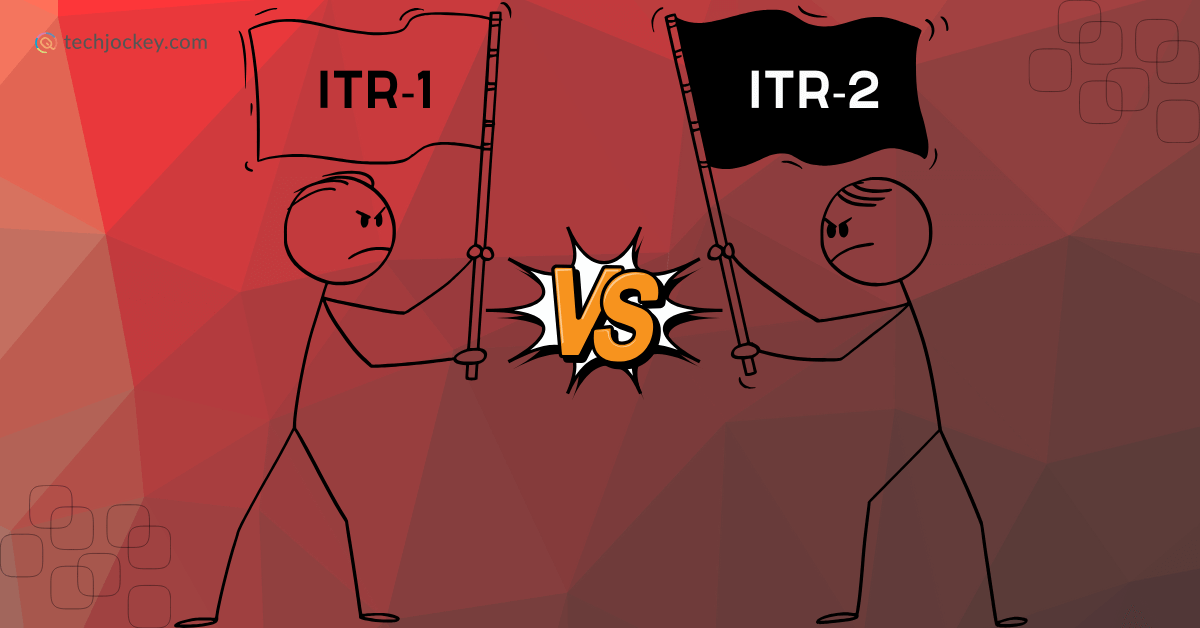
As responsible Indian taxpayers, filing our income tax returns (ITR) is an annual duty we cannot ignore. But it, more often than not, raises one critical question: Should you file ITR-1 or ITR-2? For the two forms, no matter how similar they sound, serve different types of taxpayers with income sources and eligibility criteria that are poles apart.
To make things worse, choosing the wrong form can lead to return rejection or even penalties. To thus help you make the right choice, here’s a clear comparison of ITR-1 vs ITR-2, so you can select the form that best matches your financial profile and makes taxes a little less taxing.
ITR-1, popularly called Sahaj, is the simplest income tax return form meant for Indian resident individuals with straightforward income sources. If your total income is under INR 50 lakh and it primarily comes from salary or pension, one house property, and other sources like interest from savings or fixed deposits, ITR-1 is the right choice.
If you, for instance, are a salaried employee earning INR 40 lakh annually with interest income from savings and own one rented house, and you have no capital gains or foreign income, you should file ITR-1.
ITR-2, on the contrary, serves individuals and Hindu Undivided Families (HUFs) that have multiple income sources. It is applicable to resident and non-resident taxpayers who have income from capital gains, multiple house properties, foreign income or assets, and other income sources that are excluded from ITR-1.
If you, for instance, are an IT professional earning INR 60 lakh, have capital gains of INR 10 lakh from selling shares, own two properties, and hold foreign investments, you must file ITR-2.
Understand the key distinctions between ITR-1 and ITR-2, from eligibility and income types to disclosures and reporting requirements.
| Feature | ITR-1 | ITR-2 |
|---|---|---|
| Eligibility | Resident individuals with simple income | NRIs, RNORs, and complex income portfolios |
| Income Limit | Below INR 50 lakh | All income levels |
| House Property | 1 property | Multiple properties |
| Capital Gains | Limited (LTCG up to INR 1.25L); no loss carry forward | All gains allow loss carry forward |
| Other Income | Excludes lottery, gambling | Includes lottery, gambling |
| Foreign Assets/Income | Not allowed | Allowed with disclosures |
| Agricultural Income | Up to INR 5,000 | Above INR 5,000 |
| Directorship & Unlisted Shares | Not required | Required if applicable |
| Assets & Liabilities Disclosure | Not required | Required if income > INR 1 crore |
Now that we know the primary difference between ITR-1 and 2, let’s get into the technicalities to get a broader picture. All the key distinctions between the two, as such, are listed below for your understanding…
ITR-1 is only for resident individuals with regular income sources and limited disclosures. ITR-2, conversely, includes NRIs and RNORs and taxpayers with complex income portfolios.
If your total income is less than INR 50 lakh, ITR-1 is the form you should be filing. ITR-2, contrarily, is suitable for individuals of all income levels.
While ITR-1 permits income from only one house property, ITR-2 allows reporting income from multiple properties, whether rented, self-occupied, or deemed let out.
Another key ITR-2 vs ITR-1 distinction is that ITR-1 supports only limited capital gains, specifically long-term capital gains under Section 112A up to INR 1.25 lakh, and does not allow capital loss carry forward.
ITR-2, on the other hand, requires detailed reporting of all capital gains, including both long-term and short-term gains, along with carry-forward losses from shares, mutual funds, and property sales.
ITR-1 excludes certain incomes like lottery winnings, gambling, and horse racing. ITR-2 includes these types of income, making it an essential ITR form for those who earn from such sources.
You cannot report foreign assets or income in ITR-1. If you own foreign assets or receive foreign income, you will have to file ITR-2 with detailed disclosures.
Agricultural income up to INR 5,000 can be included in ITR-1. If your agricultural income exceeds INR 5,000, you must file ITR-2.
ITR-1 does not require disclosure of company directorship or unlisted share holdings, but ITR-2 requires mandatory disclosures of these if applicable.
One final point of comparison between ITR-2 vs ITR-1 is that ITR-1 does not require disclosure of assets and liabilities, whereas ITR-2 mandates this disclosure if the total income exceeds INR 1 crore.
Here’s what to watch for when navigating the ITR-1 vs 2 choice…
Here’s a quick checklist that can help you settle the ITR-1 vs ITR-2 battle once and for all…
If you are a resident individual with salary/pension income, one house property, interest income, agricultural income under INR 5,000, and total income below INR 50 lakh, file ITR-1.
If you have capital gains, multiple house properties, foreign assets/income, etc., and are a company director or an NRI, file ITR-2.
Conclusion:
Knowing the difference between ITR-1 and 2 and choosing the right form accordingly is important for you to avoid tax notices and ensure easy tax compliance. So, if you are done understanding the two and wish to file one as soon as possible, let the Techjockey product team provide you with the best income tax software today. Give us a call right away!
When you begin your building information modeling journey, selecting the right software is crucial. Your… Read More
Highlights: The Digital Personal Data Protection Act, India, 2023 is the first comprehensive law in… Read More
Smart technology assists us in our daily lives, and it is operating silently in the… Read More
The holiday season is all about cozy lights, warm emotions, and picture-perfect memories and now,… Read More
Android trojan, for the unversed, is malware that poses a serious threat to mobile… Read More
Smartphones have completely transformed how we bank, making money transfers and payments quicker and more… Read More